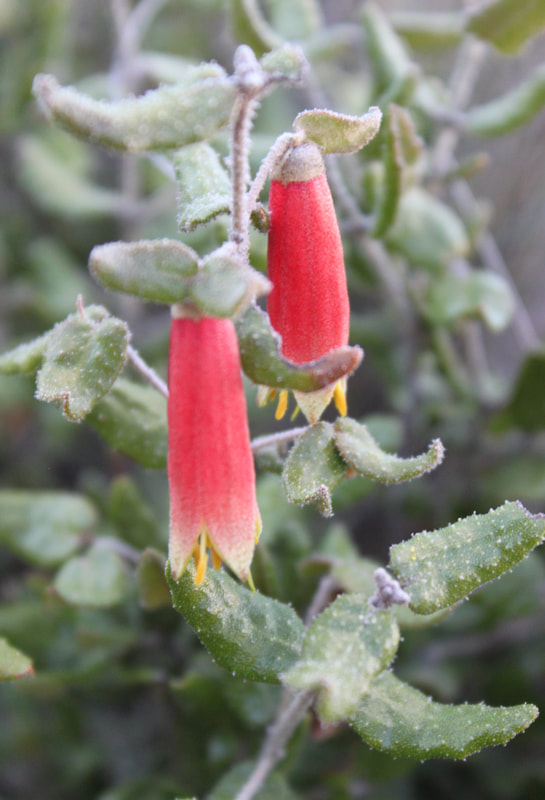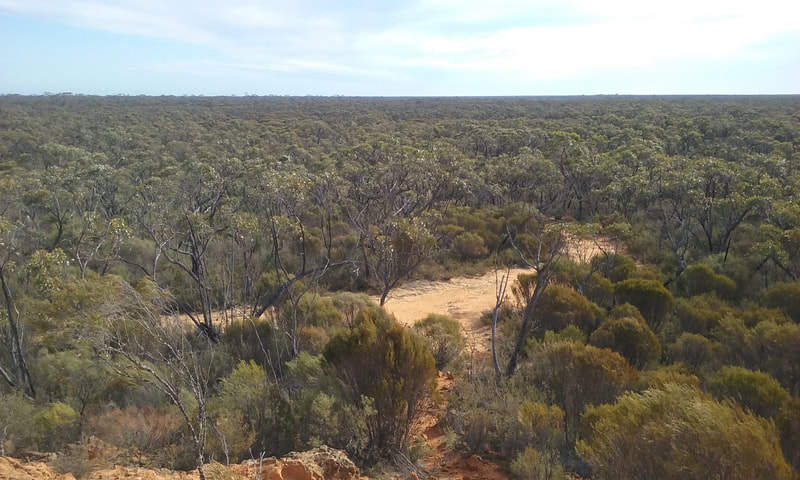Broughton's Waterhole (4WD only) is a good example of pioneer initiative. It was dug by hand (probably by Chinese workers travelling through the area) in 1879, to create a permanent water supply for stock. It differs from most local dams in that the excavated soil was removed from the site. It rarely went dry and created a permanent water supply for stock. PL Williams who ran sheep, bought the land from Broughton. The Little Desert dispute of 1968 was a watershed in Australian environmental politics, marking the beginning of a new consciousness of nature. In 1968 Sir William McDonald, Victoria's Minister of Lands, announced a rural settlement scheme for the Little Desert in Victoria's far north-west. The conservation campaign that ensued was one of unprecedented vehemence and sophistication, eventually costing McDonald his parliamentary seat.
A survey was then undertaken by three biologists who spent three months living in the Little Desert. Dr Truda Howard, a botanist, was the leader of the group, which included Geoff Edwards and Ken Norris, a reptile specialist. The group became very friendly with the locals. Every Sunday their camp at Broughton's Waterhole was visited by local farmer and botanist Alec Hicks, along with local farmers P.L. Williams and Avelyn Coutts, who would bring lunch, conversation and research suggestions. The three became known as 'the Three Blind Mice'. The 7 Hectares of land around Broughton’s Waterhole was donated to the State government by Percival Williams in 1989, some twenty-five years after his father, P.L. Williams, had first offered it.
Although the waterhole has now eroded and the area fallen into disrepair, Broughton’s Waterhole still makes for a pleasant Sunday 4WD drive and bush picnic. A variety of birds and wildlife are attracted to this oasis in the desert.
Listen back to this historical recording from 1972 recorded by the ABC for a series called Heritage featuring 6 ecological regions of Australia which included the Little Desert National Park. The recording features a 45 minute interview with the 'three blind mice' and provides first hand insight into the passion of the locals in preserving the area for generations to come. The recording also features local environmentalists and local historian Les Blake, referencing the local links of poet John Shaw Nelson and the Lost in the Bush story. Audio link.
You can find out more about the Little Desert National Park and Broughton's Waterhole story in these publications:
The Little Desert by RG Hicks (5 pages)
Defending the Little Desert (176 pages)
Little Desert west end map
A survey was then undertaken by three biologists who spent three months living in the Little Desert. Dr Truda Howard, a botanist, was the leader of the group, which included Geoff Edwards and Ken Norris, a reptile specialist. The group became very friendly with the locals. Every Sunday their camp at Broughton's Waterhole was visited by local farmer and botanist Alec Hicks, along with local farmers P.L. Williams and Avelyn Coutts, who would bring lunch, conversation and research suggestions. The three became known as 'the Three Blind Mice'. The 7 Hectares of land around Broughton’s Waterhole was donated to the State government by Percival Williams in 1989, some twenty-five years after his father, P.L. Williams, had first offered it.
Although the waterhole has now eroded and the area fallen into disrepair, Broughton’s Waterhole still makes for a pleasant Sunday 4WD drive and bush picnic. A variety of birds and wildlife are attracted to this oasis in the desert.
Listen back to this historical recording from 1972 recorded by the ABC for a series called Heritage featuring 6 ecological regions of Australia which included the Little Desert National Park. The recording features a 45 minute interview with the 'three blind mice' and provides first hand insight into the passion of the locals in preserving the area for generations to come. The recording also features local environmentalists and local historian Les Blake, referencing the local links of poet John Shaw Nelson and the Lost in the Bush story. Audio link.
You can find out more about the Little Desert National Park and Broughton's Waterhole story in these publications:
The Little Desert by RG Hicks (5 pages)
Defending the Little Desert (176 pages)
Little Desert west end map
Camping & 4WD Advice
Ideal for large groups, but there are no toilets. You need to be fully self sufficient and sand can be very loose in summer and boggy in winter, the track is cut up in places. It is best accessed after rain. Although there are tables and seating, they are barely usable at present. This is not a serviced park, so please take all your rubbish home with you.
Directions:
We recommend you download and print the Little Desert Parks west end map as signage is broken and mobile reception is poor. The most direct access is along the McDonald Highway which goes left off the Kaniva – Edenhope Road.
A few minutes travelling east of the waterhole, and Mount Turner is discovered and provides an excellent view of the surrounding terrain. In spring, orchids flower around the foot of Mount Turner. Back track to the waterhole and follow Sambells Track to the Wild Dog Spring sign. This small spring offers the local fauna welcome refreshments and tracks around the spring offer clues as to their identities. A further three kilometres south-east along Sambells Track is the turn off to Sister Hills. About the same distance along this track is a lookout which offers horizon-to-horizon views of the area including the Lawloits and Mount Arapiles. The Crater Track is featured on the East End map.
Ideal for large groups, but there are no toilets. You need to be fully self sufficient and sand can be very loose in summer and boggy in winter, the track is cut up in places. It is best accessed after rain. Although there are tables and seating, they are barely usable at present. This is not a serviced park, so please take all your rubbish home with you.
Directions:
We recommend you download and print the Little Desert Parks west end map as signage is broken and mobile reception is poor. The most direct access is along the McDonald Highway which goes left off the Kaniva – Edenhope Road.
A few minutes travelling east of the waterhole, and Mount Turner is discovered and provides an excellent view of the surrounding terrain. In spring, orchids flower around the foot of Mount Turner. Back track to the waterhole and follow Sambells Track to the Wild Dog Spring sign. This small spring offers the local fauna welcome refreshments and tracks around the spring offer clues as to their identities. A further three kilometres south-east along Sambells Track is the turn off to Sister Hills. About the same distance along this track is a lookout which offers horizon-to-horizon views of the area including the Lawloits and Mount Arapiles. The Crater Track is featured on the East End map.
Kaniva, first and last highway town in Victoria.
|
|







